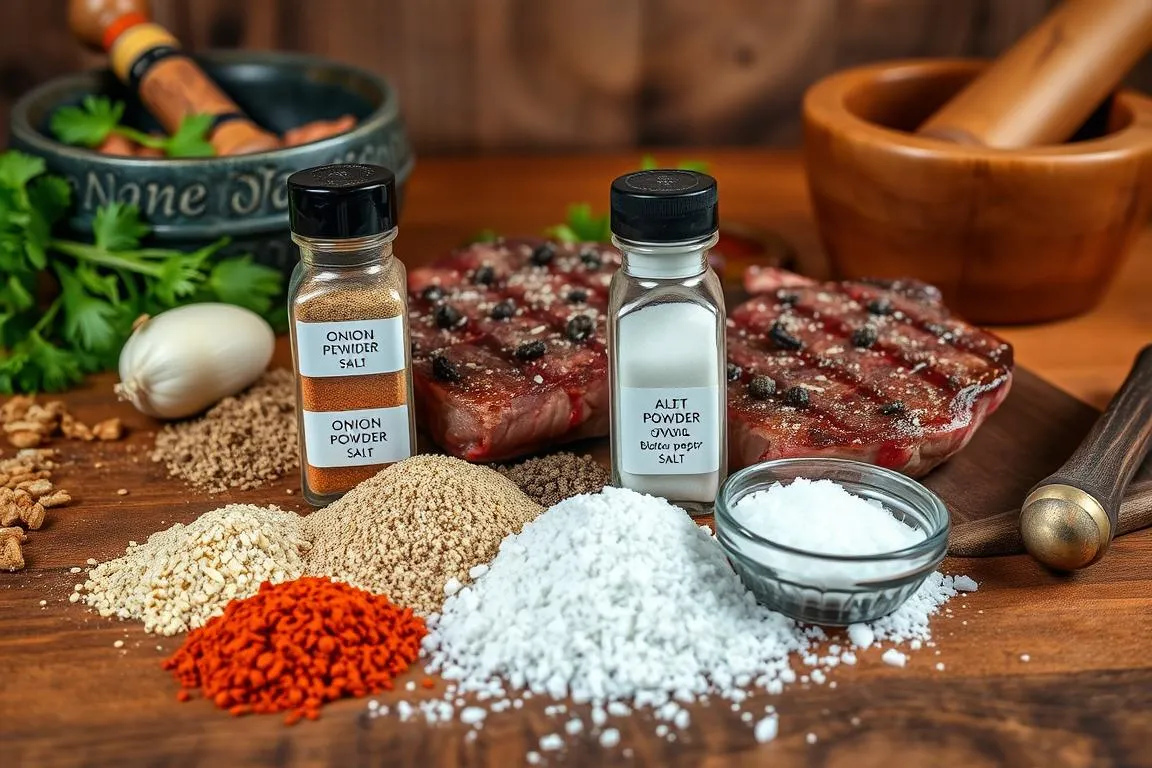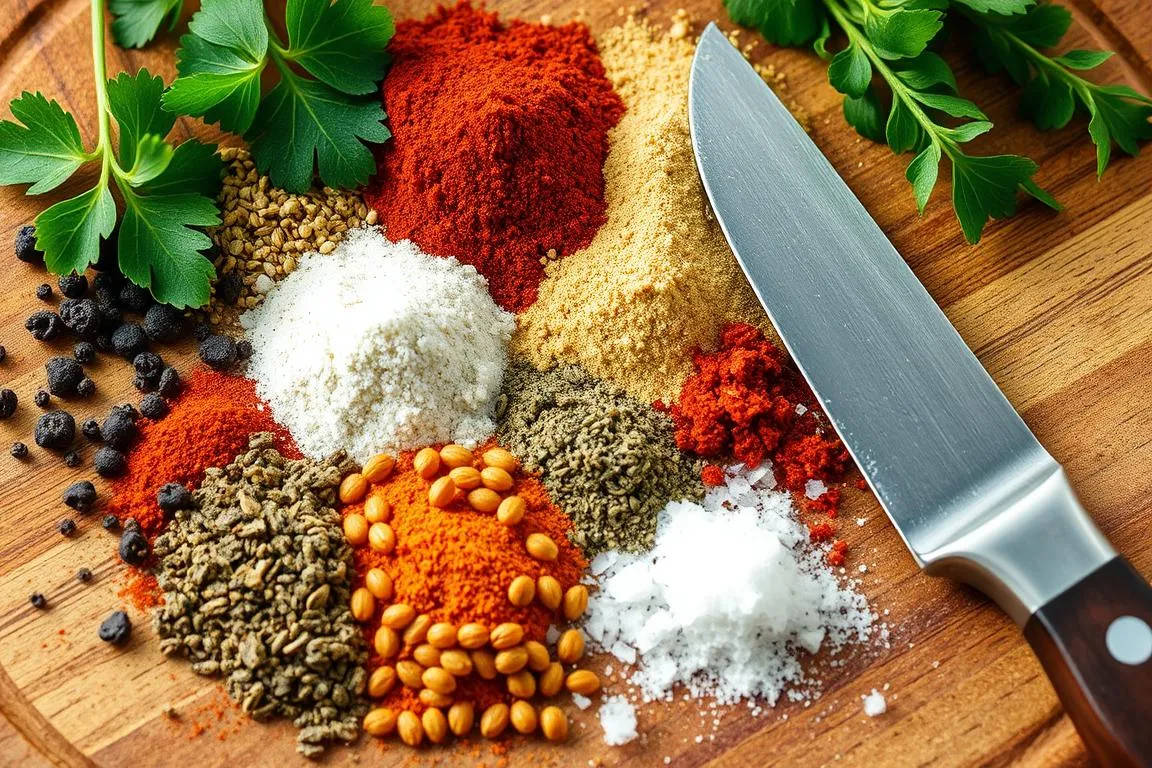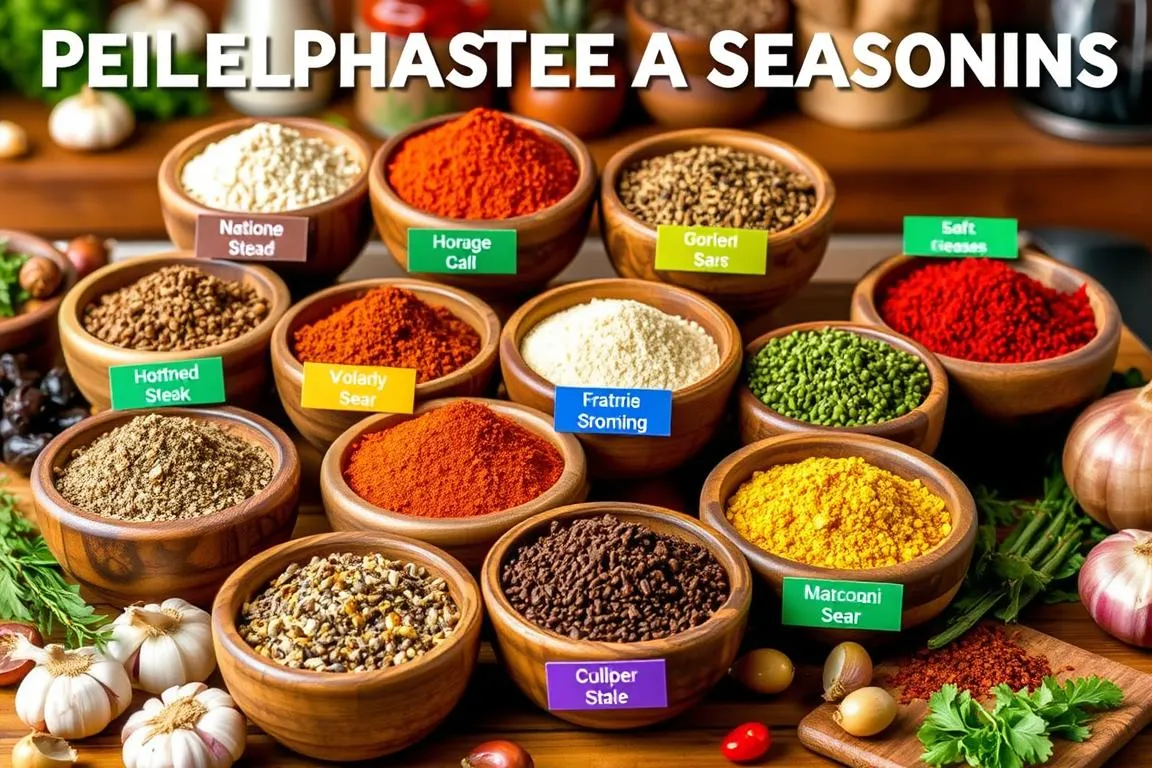What is Philly steak seasoning made of .Philly steak seasoning is more than just spices. It’s a tradition in American cooking. This secret blend turns simple meat into a flavorful dish that has won hearts for years.
This seasoning mix comes from Philadelphia’s lively streets. It’s loved by chefs and home cooks for its unique spice mix. This mix makes the Philly cheesesteak a legendary dish.
Discovering the ingredients in Philly steak seasoning opens up a world of flavors. Each spice has a story of innovation and pride. It’s a journey through the heart of American cooking.
Key Takeaways
- Philly steak seasoning is a classic American culinary tradition
- The blend combines multiple spices for complex flavor
- Origins trace back to Philadelphia’s street food culture
- Professional chefs value authentic seasoning techniques
- Understanding ingredients transforms home cooking
The Origins and History of Philadelphia Steak Seasoning
The story of Philly cheesesteak history starts in Philadelphia’s busy streets in the early 20th century. Street vendors found the perfect mix of flavors. This mix changed American street food forever.
Philly seasoning’s journey began with simple yet powerful ingredients. These ingredients turned a regular sandwich into a cultural icon. The creators knew that great taste comes from the right spices and culinary skill.
Birth of the Classic Philly Cheesesteak
In 1930, Pat and Harry Olivieri created the iconic cheesesteak near their hot dog stand in South Philadelphia. Their original sandwich had:
- Thinly sliced beef
- Grilled onions
- Crusty Italian roll
“We didn’t know we were creating a culinary revolution,” recalled local food historians about the Olivieri brothers’ unexpected invention.
Evolution of the Signature Seasoning Blend
The Philly seasoning blend grew from basic salt and pepper to a complex mix. Chefs added garlic powder, paprika, and other local ingredients. They wanted to boost the meat’s natural flavors.
Cultural Impact on American Cuisine
The Philly cheesesteak’s history went beyond local, becoming a national hit. The seasoning blend was more than flavor. It stood for innovation, street-smart cooking, and American food diversity.
Today, from food trucks to fancy restaurants, Philly seasoning inspires chefs and home cooks. It shows that amazing food has no limits.
What is Philly Steak Seasoning Made of?
Philly steak seasoning is a mix of special spices that make a simple meat dish into a masterpiece. It combines different flavors to give a taste that’s known as Philly’s own. This taste is a big part of Philadelphia’s famous food.
The main parts of Philly steak seasoning are dry spices. These spices add depth and character to the dish. Knowing these ingredients is key for anyone wanting to make a real Philly cheesesteak.
- Salt: The primary flavor enhancer
- Black pepper: Adds sharp, aromatic heat
- Garlic powder: Provides savory undertones
- Onion powder: Contributes subtle sweetness
Professional chefs know that the secret to Philly steak seasoning is in its exact mix of ingredients.
“Great seasoning is an art form that transforms simple ingredients into an extraordinary culinary experience.” – Culinary Expert
| Ingredient Category | Flavor Profile | Importance |
|---|---|---|
| Base Spices | Savory and Sharp | Essential Foundation |
| Aromatic Powders | Depth and Complexity | Flavor Enhancement |
| Herbal Elements | Subtle Background Notes | Refined Taste |
Even though some brands keep their recipes secret, home cooks can try these main ingredients. They can make their own version of this classic flavor.
Essential Base Ingredients in Traditional Philly Seasoning
The traditional Philly seasoning base is a special mix of spices. It adds depth and character to classic Philadelphia dishes. Knowing the key spices lets home cooks and food lovers make dishes that taste just like the real thing.
Choosing high-quality ingredients is key to making great seasoning. Each part is important for the perfect flavor mix.
Salt and Black Pepper: The Core Foundation
Salt and black pepper are the heart of traditional Philly seasoning. Together, they boost the natural tastes of meat and set the stage for the blend’s flavors.
- Kosher salt gives a clean, pure taste
- Freshly ground black pepper adds a sharp, warm flavor
- The right mix of salt and pepper is essential for flavor balance
Garlic and Onion Powder: Flavor Depth Creators
Garlic and onion powders are game-changers in the Philly seasoning mix. They add a rich, savory layer that makes the seasoning stand out.
| Ingredient | Flavor Profile | Culinary Impact |
|---|---|---|
| Garlic Powder | Intense, pungent | Adds depth and warmth |
| Onion Powder | Sweet, mild | Provides subtle sweetness |
Paprika’s Distinctive Role
Paprika adds color and a touch of sweetness to the Philly spice mix. Its bright red color and mild pepper taste complete the seasoning’s complex flavor.
“The magic of Philly seasoning lies in its perfectly balanced ingredients” – Philadelphia Culinary Institute
The Perfect Ratio of Herbs and Spices
Making a balanced Philly spice blend is an art that needs precision and understanding. The right Philly seasoning ratio can make or break your dish’s flavor. Professional chefs say even small changes can turn a good seasoning into an amazing one.
When finding the ideal Philly seasoning ratio, keep these key principles in mind:
- Start with a foundation of salt and black pepper
- Balance aromatic spices carefully
- Experiment with proportions
- Taste and adjust incrementally
“Seasoning is about balance, not overwhelming complexity” – Culinary Experts
Understanding how different spices work together is key. A balanced Philly spice blend usually has this percentage breakdown:
| Spice | Percentage | Purpose |
|---|---|---|
| Salt | 35% | Primary flavor enhancer |
| Black Pepper | 25% | Base heat and depth |
| Garlic Powder | 15% | Aromatic complexity |
| Paprika | 10% | Color and mild sweetness |
| Additional Herbs | 15% | Unique flavor notes |
Remember, your taste preferences are important. Your perfect Philly seasoning ratio might not match everyone’s. The key is to keep testing and refining your unique blend.
Secret Commercial Ingredients Unveiled
Exploring the world of commercial Philly seasoning secrets is fascinating. Professional spice masters create unique blends. They turn ordinary steak seasoning into amazing flavors.
Professional chefs and spice makers keep their Philly seasoning secrets close. These special ingredients make the seasoning go from good to great.
Proprietary Spice Blends
Commercial seasoning makers use advanced techniques to make their signature mixes. Their secret blends often include:
- Specialized dried herb combinations
- Rare spice extracts
- Unique flavor concentration techniques
Flavor Enhancers and Natural Additives
Spice developers add innovative Philly seasoning additives for depth and complexity:
| Additive Type | Purpose | Flavor Impact |
|---|---|---|
| Yeast Extract | Umami Enhancement | Rich, Savory Depth |
| Dried Mushroom Powder | Flavor Intensification | Earthy Undertones |
| Natural Sea Salt Crystals | Mineral Complexity | Balanced Salinity |
“The magic of great seasoning lies in its ability to transform simple ingredients into extraordinary experiences.” – Culinary Spice Expert
These commercial Philly seasoning secrets are the top of flavor engineering. They make every steak a culinary masterpiece.
Regional Variations of Philly Steak Seasoning
Philly seasoning variations tell a rich story across the United States. Each region adds its own twist to the classic seasoning. This reflects local tastes and what’s available.
“Every region has its own signature touch on the beloved Philly spice blend.” – Culinary Experts
Regional spice blends show amazing diversity. From the East Coast to the Midwest, chefs and home cooks tweak the recipe. They do this to match local tastes.
- Northeast Region: Typically uses more garlic and black pepper
- Midwest Region: Tends to incorporate smoky paprika elements
- Southern Region: Often adds a touch of cayenne for heat
- West Coast Region: Experiments with herb-infused variations
| Region | Signature Seasoning Characteristic | Key Ingredient Difference |
|---|---|---|
| Northeast | Bold and Intense | Extra Garlic Powder |
| Midwest | Smoky Undertones | Smoked Paprika |
| Southern | Spicy Kick | Cayenne Pepper |
| West Coast | Herb-Infused Blend | Fresh Dried Herbs |
Exploring these variations shows the lively side of American cooking. Each blend is a piece of a unique culinary tradition. It turns a simple seasoning into a cultural statement.
The beauty of Philly steak seasoning lies in its adaptability, embracing local flavors while maintaining its core identity.
How to Make Authentic Philly Steak Seasoning at Home
Making your own Philly seasoning is simple. A DIY spice blend lets you pick your flavors and save money. You’ll enjoy top-notch seasoning right in your kitchen.
To make the perfect spice blend, you need to know about flavors. Follow these tips to turn basic spices into a great seasoning mix.
Essential Equipment for Your Seasoning Adventure
- Measuring spoons
- Medium mixing bowl
- Airtight storage container
- Whisk or fork
- Spice grinder (optional)
Mixing Process for Perfect Seasoning
- Gather all dry spices
- Measure ingredients precisely
- Combine in a clean mixing bowl
- Whisk thoroughly to distribute evenly
- Taste and adjust as needed
Storage Recommendations
Storing your seasoning right keeps its flavor strong. Store it in a cool, dark spot. Keep it away from sunlight and moisture.
| Storage Location | Estimated Shelf Life | Recommended Container |
|---|---|---|
| Pantry | 3-6 months | Airtight glass jar |
| Refrigerator | 6-9 months | Sealed container |
“The secret to great seasoning is not just ingredients, but passion and precision.” – Professional Chef
Pro tip: Label your container with the date of preparation. This helps track freshness and ensures the best flavor in every dish.
Common Mistakes When Making Philly Steak Seasoning
Making the perfect Philly steak seasoning needs careful attention. Many home cooks make mistakes that can ruin the flavor. Knowing these mistakes can help you make a better seasoning mix.
Common errors in Philly spice blends often come from a few main issues. These can greatly affect the taste. Let’s look at the most common mistakes and how to avoid them:
- Using Stale Spices: Old spices lose their strength and make the seasoning taste flat
- Incorrect Spice Ratios: Mixing ingredients without the right amounts
- Poor Storage Techniques: Storing spices in places with heat, light, or moisture
“A great seasoning is about precision and fresh ingredients” – Philadelphia Culinary Institute
Here’s a detailed look at typical Philly seasoning mistakes:
| Mistake | Consequence | Solution |
|---|---|---|
| Uneven Grinding | Inconsistent Flavor Distribution | Use a high-quality spice grinder |
| Ignoring Spice Quality | Bland Seasoning Blend | Purchase fresh, high-grade spices |
| Overcrowding Spices | Muddled Taste Profile | Maintain balanced proportions |
Professional chefs say to keep your Philly steak seasoning fresh. Buy small amounts and store them in airtight containers away from sunlight. Making the perfect spice blend is an art that gets better with practice and detail.
Pairing and Usage Suggestions
Philly seasoning is more than just for cheesesteaks. It opens up a world of flavors for anyone who loves to cook. Whether you’re cooking at home or in a restaurant, this seasoning can change your dishes.
Traditional Applications
The classic use of Philly seasoning is in the famous cheesesteak. It adds a deep flavor that captures the spirit of Philadelphia street food.
- Coat thinly sliced beef before grilling
- Sprinkle on sautéed onions and peppers
- Mix into sandwich spreads for extra kick
Creative Modern Uses
Today, Philly seasoning is used in many new ways. Chefs and home cooks are finding creative ways to use it in different dishes.
| Dish Category | Seasoning Application |
|---|---|
| Roasted Vegetables | Sprinkle before baking |
| Popcorn | Dust as a flavor enhancer |
| Scrambled Eggs | Mix into egg mixture |
“Philly seasoning isn’t just a condiment—it’s a culinary adventure waiting to be explored.” – Professional Chef
Try this amazing spice blend to discover new flavors in your cooking. It’s great for both classic dishes and new creations. Philly seasoning is a key to unlocking endless possibilities in the kitchen.
Alternative Dietary Versions
Dietary restrictions shouldn’t stop food lovers from enjoying tasty flavors. Philly steak seasoning can be adapted for different nutritional needs. This includes low-sodium and vegan options.
To make low-sodium Philly seasoning, you need to swap out ingredients. Use herbs and spices instead of salt to keep flavors rich without extra sodium.
- Use dried herbs like thyme and rosemary
- Incorporate potassium-based salt alternatives
- Increase aromatics like garlic and onion powder
For a vegan Philly spice blend, skip animal products. Use plant-based seasonings that bring out the rich taste of Philly seasoning.
| Traditional Ingredient | Vegan Replacement |
|---|---|
| Beef Stock Powder | Mushroom Powder |
| Worcestershire Sauce | Soy Sauce or Tamari |
| Animal Fats | Nutritional Yeast |
“Great seasoning knows no dietary boundaries” – Culinary Experts
The secret to successful adaptation is keeping the flavor true while meeting dietary needs. Try different herbs to find your ideal low-sodium or vegan Philly spice blend.
Conclusion
Philly steak seasoning is more than just spices. It’s a journey that connects us to Philadelphia’s rich food traditions. To master it, you need patience, experimentation, and a deep understanding of its unique flavors.
Creating the perfect Philly spice blend is a mix of tradition and personal touch. Home cooks can elevate their dishes by grasping the seasoning’s complex elements. By choosing top-notch ingredients and trying new twists, each cook adds their own flair to this classic taste.
The beauty of Philly steak seasoning is its flexibility. It’s great for making a classic cheesesteak or for trying new recipes. Your adventure in cooking is just beginning, filled with new tastes, techniques, and your own creative ideas.
Keep honing your cooking skills, and remember, great cooking comes from passion, precision, and a love for learning. Philly steak seasoning is your gateway to exploring, experimenting, and making dishes that share a story of flavor and tradition.
FAQ
What exactly is Philly Steak Seasoning?
Philly Steak Seasoning is a special spice mix. It’s made to make Philly cheesesteaks taste better. It usually has salt, black pepper, garlic powder, onion powder, and paprika.
Can I make Philly Steak Seasoning at home?
Yes, you can make it at home! Use salt, black pepper, garlic powder, onion powder, paprika, and herbs. The trick is to mix them right to get that classic taste.
Is Philly Steak Seasoning gluten-free?
Most Philly Steak Seasoning is gluten-free. But, always check the ingredients to make sure. Or make your own to avoid gluten.
How long can I store homemade Philly Steak Seasoning?
Store it in an airtight container in a cool, dry place. It lasts 6-12 months. For the best taste, use it within 6 months.
What meats work best with Philly Steak Seasoning?
It’s great with beef, but also with chicken, pork, mushrooms, and veggies. It’s versatile and tasty.
Are there low-sodium versions of Philly Steak Seasoning?
Yes, you can make a low-sodium version. Use less salt and more garlic powder, onion powder, and herbs. It’s flavorful and low in sodium.
Can vegetarians use Philly Steak Seasoning?
Most of the ingredients are plant-based. Vegetarians can use it to flavor tofu, seitan, or tempeh. It adds depth to their dishes.
What makes commercial Philly Steak Seasonings different?
Commercial blends have unique spice mixes and flavor enhancers. They might include MSG, special herbs, or salt preparations.
How do regional variations affect Philly Steak Seasoning?
Regions adjust the seasoning to their taste. They might add local spices, change salt levels, or include unique herbs. It shows their culinary traditions.
What’s the best way to apply Philly Steak Seasoning?
Apply it generously before cooking. Let it sit on the meat or veggies for 15-30 minutes. This helps the spices penetrate and enhance the flavor.



